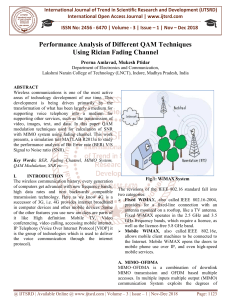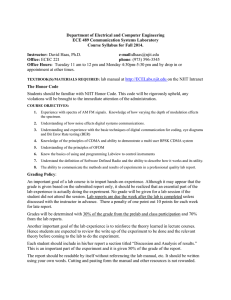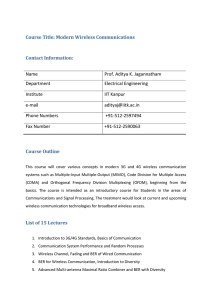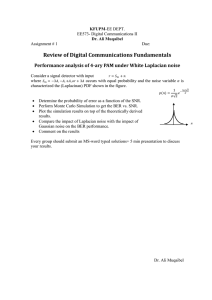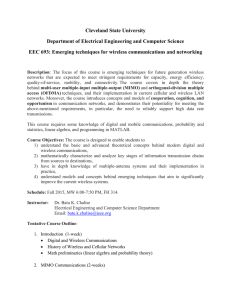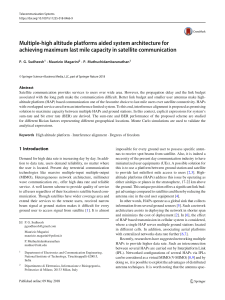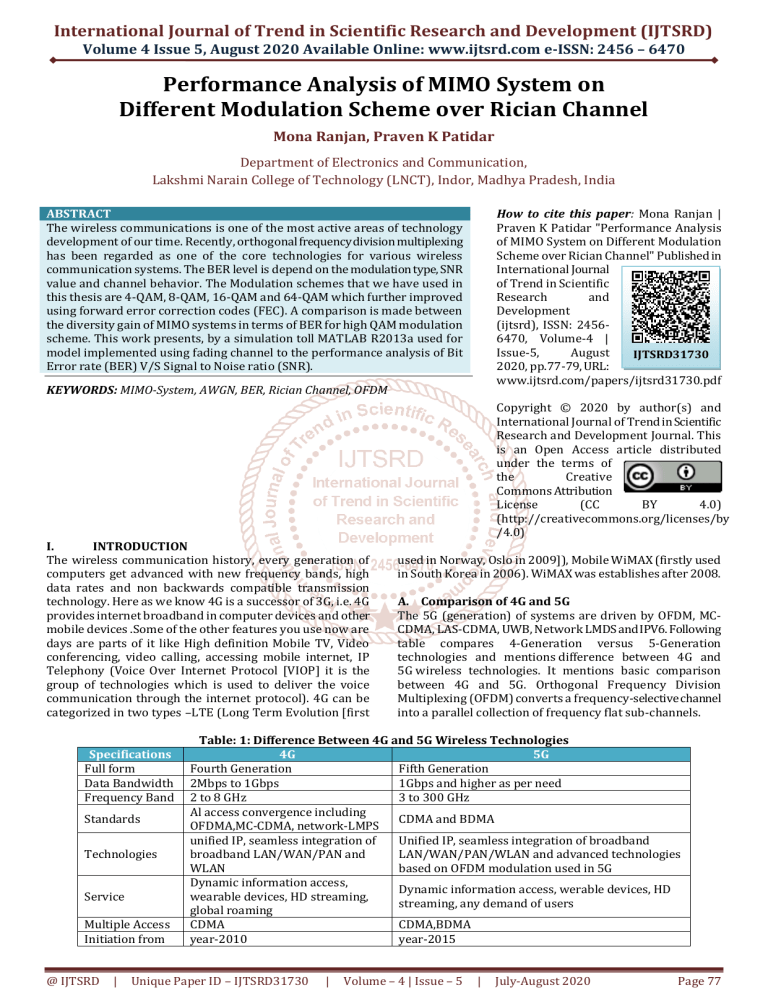
International Journal of Trend in Scientific Research and Development (IJTSRD)
Volume 4 Issue 5, August 2020 Available Online: www.ijtsrd.com e-ISSN: 2456 – 6470
Performance Analysis of MIMO System on
Different Modulation Scheme over Rician Channel
Mona Ranjan, Praven K Patidar
Department of Electronics and Communication,
Lakshmi Narain College of Technology (LNCT), Indor, Madhya Pradesh, India
ABSTRACT
The wireless communications is one of the most active areas of technology
development of our time. Recently, orthogonal frequency division multiplexing
has been regarded as one of the core technologies for various wireless
communication systems. The BER level is depend on the modulation type, SNR
value and channel behavior. The Modulation schemes that we have used in
this thesis are 4-QAM, 8-QAM, 16-QAM and 64-QAM which further improved
using forward error correction codes (FEC). A comparison is made between
the diversity gain of MIMO systems in terms of BER for high QAM modulation
scheme. This work presents, by a simulation toll MATLAB R2013a used for
model implemented using fading channel to the performance analysis of Bit
Error rate (BER) V/S Signal to Noise ratio (SNR).
How to cite this paper: Mona Ranjan |
Praven K Patidar "Performance Analysis
of MIMO System on Different Modulation
Scheme over Rician Channel" Published in
International Journal
of Trend in Scientific
Research
and
Development
(ijtsrd), ISSN: 24566470, Volume-4 |
Issue-5,
August
IJTSRD31730
2020, pp.77-79, URL:
www.ijtsrd.com/papers/ijtsrd31730.pdf
KEYWORDS: MIMO-System, AWGN, BER, Rician Channel, OFDM
I.
INTRODUCTION
The wireless communication history, every generation of
computers get advanced with new frequency bands, high
data rates and non backwards compatible transmission
technology. Here as we know 4G is a successor of 3G, i.e. 4G
provides internet broadband in computer devices and other
mobile devices .Some of the other features you use now are
days are parts of it like High definition Mobile TV, Video
conferencing, video calling, accessing mobile internet, IP
Telephony (Voice Over Internet Protocol [VIOP] it is the
group of technologies which is used to deliver the voice
communication through the internet protocol). 4G can be
categorized in two types –LTE (Long Term Evolution [first
Specifications
Full form
Data Bandwidth
Frequency Band
Standards
Technologies
Service
Multiple Access
Initiation from
@ IJTSRD
|
Copyright © 2020 by author(s) and
International Journal of Trend in Scientific
Research and Development Journal. This
is an Open Access article distributed
under the terms of
the
Creative
Commons Attribution
License
(CC
BY
4.0)
(http://creativecommons.org/licenses/by
/4.0)
used in Norway, Oslo in 2009]), Mobile WiMAX (firstly used
in South Korea in 2006). WiMAX was establishes after 2008.
A. Comparison of 4G and 5G
The 5G (generation) of systems are driven by OFDM, MCCDMA, LAS-CDMA, UWB, Network LMDS and IPV6. Following
table compares 4-Generation versus 5-Generation
technologies and mentions difference between 4G and
5G wireless technologies. It mentions basic comparison
between 4G and 5G. Orthogonal Frequency Division
Multiplexing (OFDM) converts a frequency-selective channel
into a parallel collection of frequency flat sub-channels.
Table: 1: Difference Between 4G and 5G Wireless Technologies
4G
5G
Fourth Generation
Fifth Generation
2Mbps to 1Gbps
1Gbps and higher as per need
2 to 8 GHz
3 to 300 GHz
Al access convergence including
CDMA and BDMA
OFDMA,MC-CDMA, network-LMPS
unified IP, seamless integration of
Unified IP, seamless integration of broadband
broadband LAN/WAN/PAN and
LAN/WAN/PAN/WLAN and advanced technologies
WLAN
based on OFDM modulation used in 5G
Dynamic information access,
Dynamic information access, werable devices, HD
wearable devices, HD streaming,
streaming, any demand of users
global roaming
CDMA
CDMA,BDMA
year-2010
year-2015
Unique Paper ID – IJTSRD31730
|
Volume – 4 | Issue – 5
|
July-August 2020
Page 77
International Journal of Trend in Scientific Research and Development (IJTSRD) @ www.ijtsrd.com eISSN: 2456-6470
II.
Channel
A channel model is then applied to the transmitted signal. The model allows for the signal to noise ratio, multipath, and peak
power clipping to be controlled. The signal to noise ratio is set by adding a known amount of white noise to the transmitted
signal. Multipath delay spread then added by simulating the delay spread using an FIR filter. The length of the FIR filter
represents the maximum delay spread, while the coefficient amplitude represents the reflected signal magnitude. The most
important characteristics of wireless channel are:
Path loss,
Fading,
Interference,
Doppler shift.
A. Ricean fading model
The Ricean fading model is similar to the Rayleigh fading model, except that in Ricean fading, a strong dominant component is
present. This dominant component is a stationary (non fading) signal and is commonly known as the LOS (Line of Sight
Component).
III.
MIMO System
A channel model is needed to properly assess a MIMO channel. In MIMO, the system configuration typically
contains M antennas at the transmitter and N antennas at the receiver front end as illustrated in the following figure 1.
Fig. 1: MIMO System
IV.
Simulation Results and discussion
We have developed the simulator in Matlab using modular approach. Each block of the transmitter, receiver and channel is
written in separate ´.m´ extinction (Matlab file). The main procedure also contains initialization parameters, input binary data
and delivers results in BER/SNR. The parameters that can be set at the time of initialization are the number of simulated OFDM
symbols, CP length, modulation and coding rate, range of SNR values and channel model for simulation.
The Rician channel is used to simulate the system to achieve the performance limit. The BER and SNR curve for Rician channel
are shown in figure 2 and comparatively perform of Rician cannel with different modulation scheme result shown in figure 3.
Performance of OFDM over Rician channel
0
10
-1
BER
10
-2
10
-3
10
-5
0
5
10
SNR
15
20
25
Fig. 2: Performance of OFDM over Rician communication channel
@ IJTSRD
|
Unique Paper ID – IJTSRD31730
|
Volume – 4 | Issue – 5
|
July-August 2020
Page 78
International Journal of Trend in Scientific Research and Development (IJTSRD) @ www.ijtsrd.com eISSN: 2456-6470
0
BER performance of QAM-OFDM over RICIAN channel
10
QAM-4
QAM-8
QAM-16
QAM-32
-1
BER
10
-2
10
-3
10
-4
10
-5
0
5
10
15
20
SNR
Fig. 3: BER performance of different QAM-OFDM over RICIAN
Conclusion and Result Analysis:
In conclusion, wireless communications globally is
something that people can expect as technology advances.
Wireless communications has a lot of benefits and can make
the world a lot more efficient. In this performance, we have
used the Alamouti scheme with communication Rician
channel and different modulation techniques. The
performance is displayed in figure 3 in terms of the BER
verses SNR logarithmic plot. In the figure 3 in this plot we
analysis the 32-QAM, SNR is increased 4.1 dB on BER at 10-2
as compared to 16-QAM and Modulation Techniques at a
constant signal power.
REFRENCES
[1] Salah Talha Babiker (2017). New Wavelet Transform
Smart Processor for Massive MIMO System, American
Journal of Engineering Research (AJER) 6(1), pp. 179183.
[2] Banhijit Bhattacharyya and Somdutta Bhattacharya
(2013). Emerging Fields in 4G Technology, it’s
Applications & Beyond-An Overview, International
Journal of Information and Computation Technology,
3(4), pp. 251-260.
[3] Sweta Rawat & Prabhat Sharma (2016). Review Paper
on MIMO-OFDM System for WiMAX (IEEE 802.16)
based on Cognitive Radio Networks, International
Journal of Innovative Research in Computer and
Communication Engineering, 4(10).
[4] Saurabh Dixit et al. (2019). MIMO-OFDM in a
Cooperative Frequency Selective Fading Channel: An
Analysis, Journal of Computer Networks and
Communications, 2019(9107505), 1-7.
[5] David Nunez Cuadrado (2019). Antenna Selection in
MIMO-OFDM systems, SBrT2019, 29/09/2019–
02/10/2019, 1-5.
[6] A. Vani et al. (2019). Improvement of BER for MIMOOFDM System Using Wavelet Transform, International
Journal of Innovative Technology and Exploring
Engineering (IJITEE), 9(9), 204-207.
[7] J Ravindra Babu et al. (2019). A Multi User based Joint
Bit Error Rate
improvements
in
PDMA,
@ IJTSRD
|
Unique Paper ID – IJTSRD31730
|
[8]
[9]
[10]
[11]
[12]
[13]
[14]
[15]
25
International Journal of Recent Technology and
Engineering (IJRTE), 8(4), 11043-11048.
Sneha Jojare (2018) et al. SNR Performance of Various
MIMO-OFDM Detectors using V-BLAST, International
Journal of Computer Applications, 179 (32), 17-20.
Shantanu Pathak and Shagun Batra (2012). Next
Generation 4G WiMAX Networks IEEE 802.16
Standard, CoNeCo, WiMo, NLP, CRYPSIS, ICAIT, ICDIP,
ITCSE, CS & IT (7), pp. 507–518.
S.M. Lalan Chowdhiury and P. Venkateswaran (2010).
Performance Analysis of WiMAX PHY, IEEE CASCOM
Post Graduate Student Paper Conference
2010,
Dept of electronics & Tele-Communication Engg.,
Jadavpure University, Kollata, India.
K.Shamganth and M.P.Reena, Capacity Enhancement in
WLAN using MIMO, Special Issue of IJCCT Vol.1 Issue
2,3,4; 2010 for International Conference [ACCTA2010], 3-5 August 2010.
Mehdi Ahmadi, EhsanRohani, Pooya Monshizadeh
Naeeni and Sied Mehdi Fakhraie, “Modeling and
Performance Evaluation of IEEE 802.22 Physical
Layer”. 2nd International Conference on Future
Computer and Communication (ICFCC)-2010, Wuhan,
ISBN: 978-1-4244-5821-9, 21-24 May 2010, Vol 3 V362 - V3-66, INSPEC Accession Number : 11538274
T. A Latef, T O’Farrell, S. Boussakta, WLAN and
Bluetooth Coexistence: A Comparative Study of
Convolutional Coding versus Turbo Coding, University
of Leeds, UK EnisAkay and Ender Ayanoglu, High
Performance Viterbi Decoder for OFDM Systems.
Y. Li, J. H. Winters and N. R. Sollenberger, “MIMO-OFDM
for Wireless Communications: Signal Detection with
Enhanced Channel Estimation”, IEEE Transaction on
Communications, Vol. 50, Issue 9, pp 1471-1477, 2009.
S. Moghe and R. Upadhyay, “Comparison of SISO and
MIMO Techniques in 802.11n Wireless Local Area
Network”, International Conference on Emerging
Trends in Electronic and Photonic Devices & Systems,
pp 245-246, 2009
Volume – 4 | Issue – 5
|
July-August 2020
Page 79


